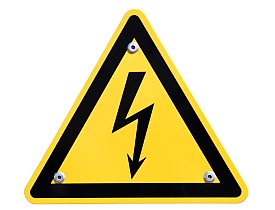Dangerous Wires Warning Signs
 As reported by the National Fire Protection Association, fixed wiring is the second-leading cause of electrical-related house fires (lamps, light fixtures, and light bulbs are first). And while nearly all wiring hazards are theoretically preventable, the fact that you can’t see most of your house’s wiring means that many electrical hazards aren’t discovered until it’s too late. A professional electrical inspection is the best way to discover hidden wiring hazards in your home. However, as a homeowner, you should learn the following 8 warning signs that something is amiss.
As reported by the National Fire Protection Association, fixed wiring is the second-leading cause of electrical-related house fires (lamps, light fixtures, and light bulbs are first). And while nearly all wiring hazards are theoretically preventable, the fact that you can’t see most of your house’s wiring means that many electrical hazards aren’t discovered until it’s too late. A professional electrical inspection is the best way to discover hidden wiring hazards in your home. However, as a homeowner, you should learn the following 8 warning signs that something is amiss.
1. Frequent Circuit Trips
It’s perfectly normal to go years without having to reset a tripped breaker or replace a blown fuse. If you have a circuit that trips fairly often, there’s a good chance that: 1) it’s overloaded (the power demands on the circuit exceed its safe capacity), or 2) there is a short or fault somewhere in the wiring run or any devices connected to the circuit.
2. Dimming or Flickering Lights
Dimming lights are another common indication of circuit overload or improper wiring. Flickering lights can result from damaged fixture wiring (especially if it’s affecting just one of two or more fixtures on the same circuit), a problem with the switch, or a fault somewhere. In older homes with 60-amp service panels (breaker boxes), underpowered fixtures and appliances may indicate that the household system is being overtaxed and should be upgraded.
3. Overrated Circuit
It’s not always easy to recognize this hazard, but if you’re at your service panel and see a 20-amp (or larger) breaker or fuse on a standard lighting/receptacle circuit, it could be that someone has “fixed” a trip-prone circuit by installing a larger breaker than the circuit wiring is designed for. Standard circuits are 15 amps and should have a 15-amp breaker; a 20-amp breaker will allow overloads without tripping, heating the circuit wires, and possibly causing a fire. NOTE: 20-amp receptacle circuits are common in kitchens and garages, while 15 amps is standard for most other rooms.
4. Buzzing or Charred Outlets and Switches
Outlets (receptacles)and switches are never supposed to buzz, and their faces or coverplates should never be hot to the touch. These are clear warning signs, often indicating a faulty device, loose wiring inside the box, or arcing between the wire conductors and the device, box or coverplate. Charred devices should be inspected immediately, as well. It’s normal for most dimmer switches and coverplates to be warm, but they should not be hot.
5. “Live” Appliances
If touching an appliance body (or a cord plug or really anything that uses electricity) gives you a zing or even a mild tingling sensation, unplug it and have it checked out, or chuck it. Same goes with buzzing light fixtures.
6. Smell Something Burning?
Even the faintest scent of overheated plastic can be a big warning sign. If you can’t find the source of a burning smell, whether it’s in a room or next to an appliance, assume that wiring is a possible culprit.
7. Damaged or Worn Insulation
Without completely intact insulation, electrical wiring is extremely dangerous. Frayed, cut, or burned insulation on any wire is a serious hazard. Also, cable splices should always occur inside an approved junction box.
8. Funny Wiring
This is no joke, of course. Stories of DIYers using extension cords for circuit wiring are not apocrypha. It happens, and it’s the equivalent of using a garden hose for water-supply pipes. If you find inappropriate wiring anywhere in your house, assume the worst; it’s time for a complete inspection.
Inspection is the Best Defense
The U. S. Consumer Product Safety Commission recommends an electrical inspection of your home in these cases:
- every 10 to 40 years
- if you’ve added substantial new loads (such as high-wattage appliances)
- if you detect any warning signs of wiring problems.
Always hire a certified electrician or electrical inspector to perform this vital safety inspection.
Updated December 6, 2017.
Looking for a Pro? Call us (866) 441-6648

Electrical Average Costs
Electricians Experiences

Restaurant Ceiling Fan Installation To Beat The Florida Heat

Parking Lot Lights Restored So Employees Can Reach Cars Safely



